Introduction
Traditionally, intelligence is:
- viewed as a measurable ability (IQ tests), stable capacities (Feldman, 2016; Hanafin, 2014);
- referred to linguistic/mathematical skills in education.
The 1980s:
- intelligence is analyzed in the context of learning styles (Selmi, Gallagher, & Mora-Flores, 2015).
During a long period of time, intelligence was traditionally viewed as a person’s ability that can be represented in the form of stable capacities, which can be measured with the help of IQ tests and other similar tests (Feldman, 2016; Hanafin, 2014). In education, intelligence was discussed with reference to linguistic and mathematical skills. However, in the 1980s, the phenomenon of intelligence became also analyzed in the context of people’s learning styles (Selmi, Gallagher, & Mora-Flores, 2015). As a result, educators and psychologists received an opportunity to explore students’ learning from a different perspective.
Howard Gardner’s Theory of Multiple Intelligences:
- a complex view on intelligence (Feldman, 2016).
This project:
- describes the theory in detail;
- accentuates its role for students’ learning.
It is important to state that this approach to discussing the aspects of intelligence and cognitive abilities of individuals was proposed by Howard Gardner who formulated his Theory of Multiple Intelligences as a complex view on the concept of intelligence (Feldman, 2016). Currently, the theory is applied in the sphere of education in order to explain students’ learning preferences and abilities. The purpose of this project is to describe the Theory of Multiple Intelligences in detail and accentuate its role for students’ learning.
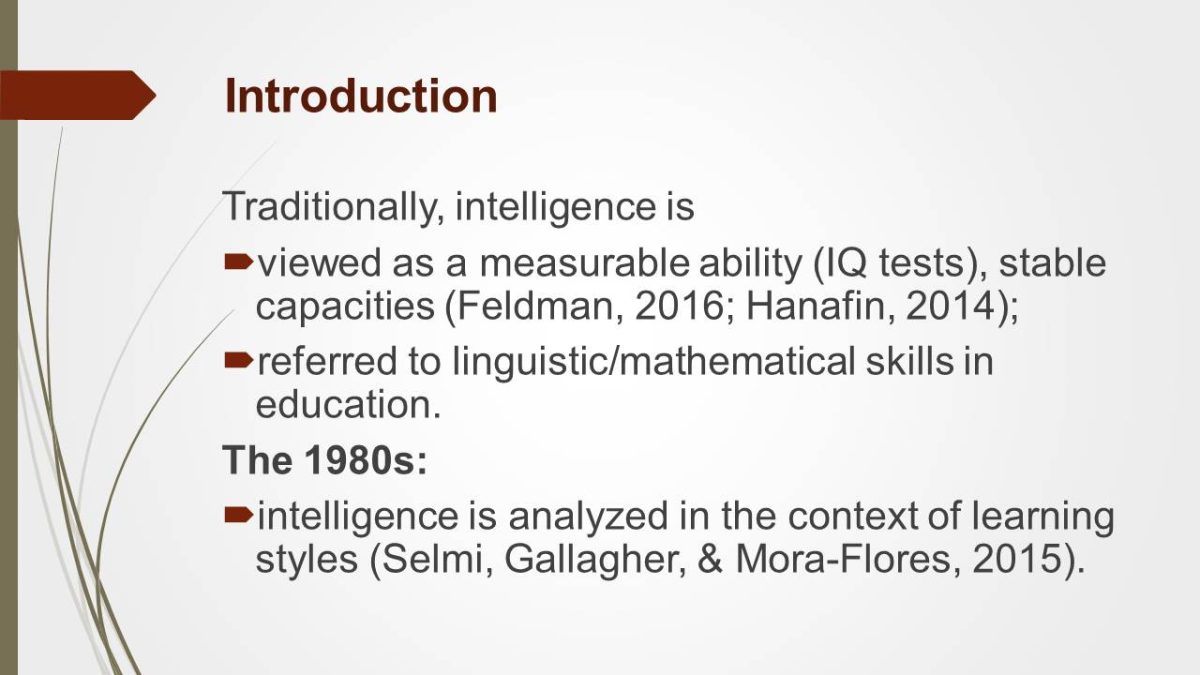

Reasoning for Selecting Theory of Multiple Intelligences to Discuss
The Theory of Multiple Intelligences
- focuses on persons’ independent abilities that can develop (Selmi et al., 2015);
- views intelligences as non-innate capacities (Hanafin, 2014);
- answers the question “How are you smart?” NOT “How smart are you?” (Feldman, 2016, p. 62).
Gardner’s Theory of Multiple Intelligences is selected for the detailed analysis because this theoretical model is focused on persons’ independent or autonomous abilities that reflect a specific intelligence and can be developed during a life (Selmi et al., 2015). Thus, such intelligence is not an innate capacity of a person (Hanafin, 2014). In contrast to other theories that support individuals’ learning, the Theory of Multiple Intelligences answers the question “How are you smart?” rather than “How smart are you?” (Feldman, 2016, p. 62).
The Theory of Multiple Intelligences
- is a unique contemporary perspective to examine learning, problem-solving, and decision-making.
- There may be more intelligences (Feldman, 2016).
Furthermore, while determining eight intelligences, Gardner also promotes the idea that there may be more capabilities or intelligences to explain individuals’ learning and problem-solving (Feldman, 2016). Therefore, it is possible to state that Gardner proposed a unique perspective, from which it is important to examine persons’ learning, problem-solving activities, and decision-making. The detailed examination of this theory allows for understanding specifics of students’ learning styles, as well as differences in them.
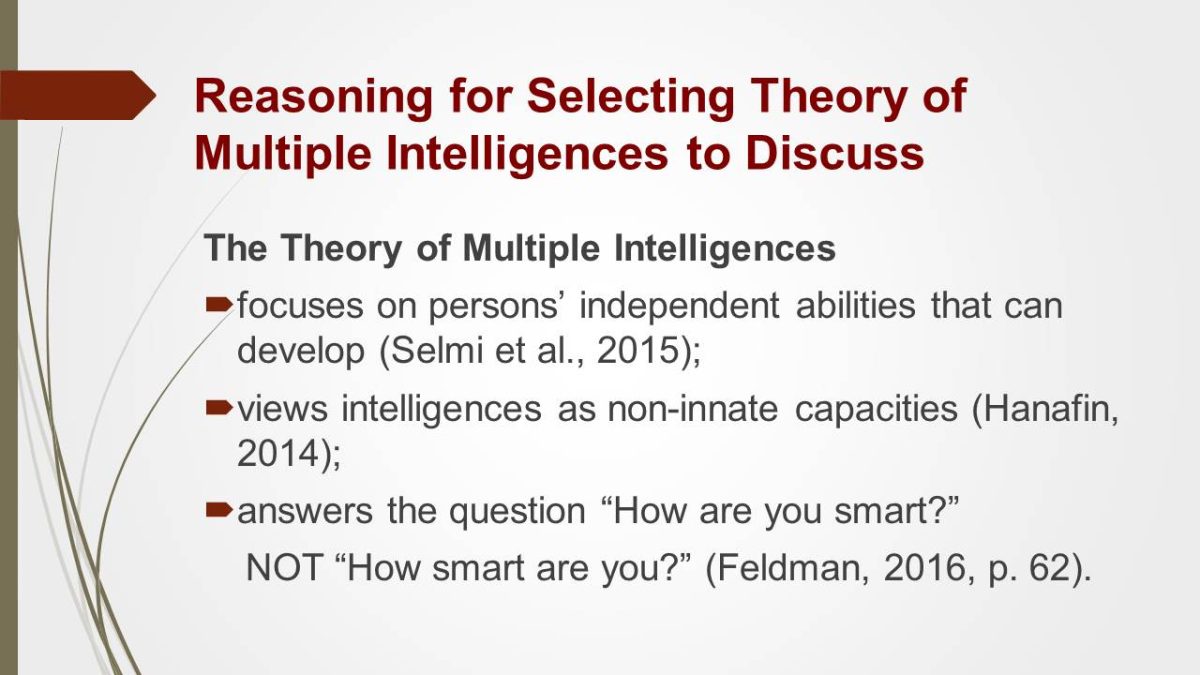
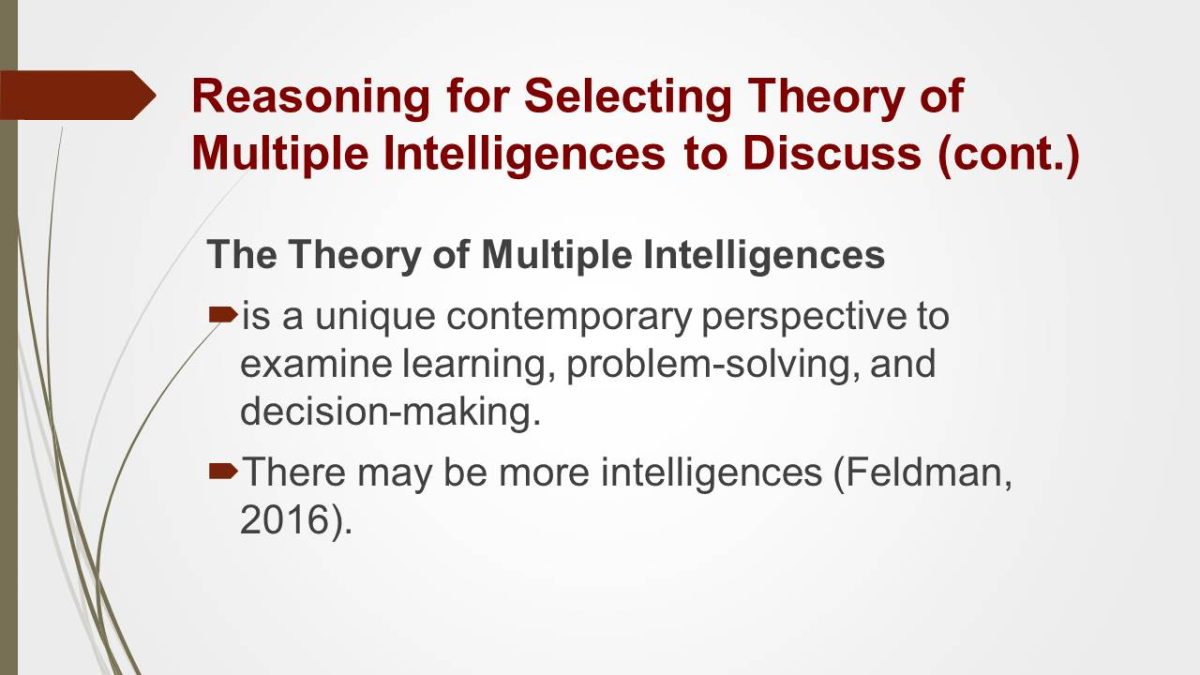
Howard Gardner and His Theory
The list of intelligences:
- Logical-mathematical;
- Linguistic;
- Spatial;
- Interpersonal;
- Intrapersonal;
- Musical;
- Bodily kinesthetic;
- Naturalist (Feldman, 2016).
Presented in Gardner’s Frames of Mind in 1983 (Feldman, 2016; Hanafin, 2014).
In 1983, Gardner formulated the Theory of Multiple Intelligences from the perspective of a developmental psychologist, and his knowledge was based on identifying seven intelligences or capacities: logical-mathematical, linguistic, spatial, interpersonal, intrapersonal, musical, and bodily kinesthetic (Feldman, 2016). This concept was described in detail in Gardner’s seminal work Frames of Mind (1983). It is important to pay attention to the fact that a naturalist intelligence was added to the list later (Feldman, 2016; Hanafin, 2014).
Intelligence: “is not dominated by a specific continuum of single types of activities; instead, a wide range of cognitive abilities relate to the use of various modalities” (Selmi et al., 2015, p. 50).
Outcomes: ideas, actions, and products (Hanafin, 2014).
According to this theory, intelligence “is not dominated by a specific continuum of single types of activities; instead, a wide range of cognitive abilities relate to the use of various modalities” (Selmi et al., 2015, p. 50). In addition, it was noted by Gardner that one person can use or develop several specific intelligences at once, and intelligence as a phenomenon can be presented and measured in ideas, actions, and products rather than scores or other types of measures (Hanafin, 2014).
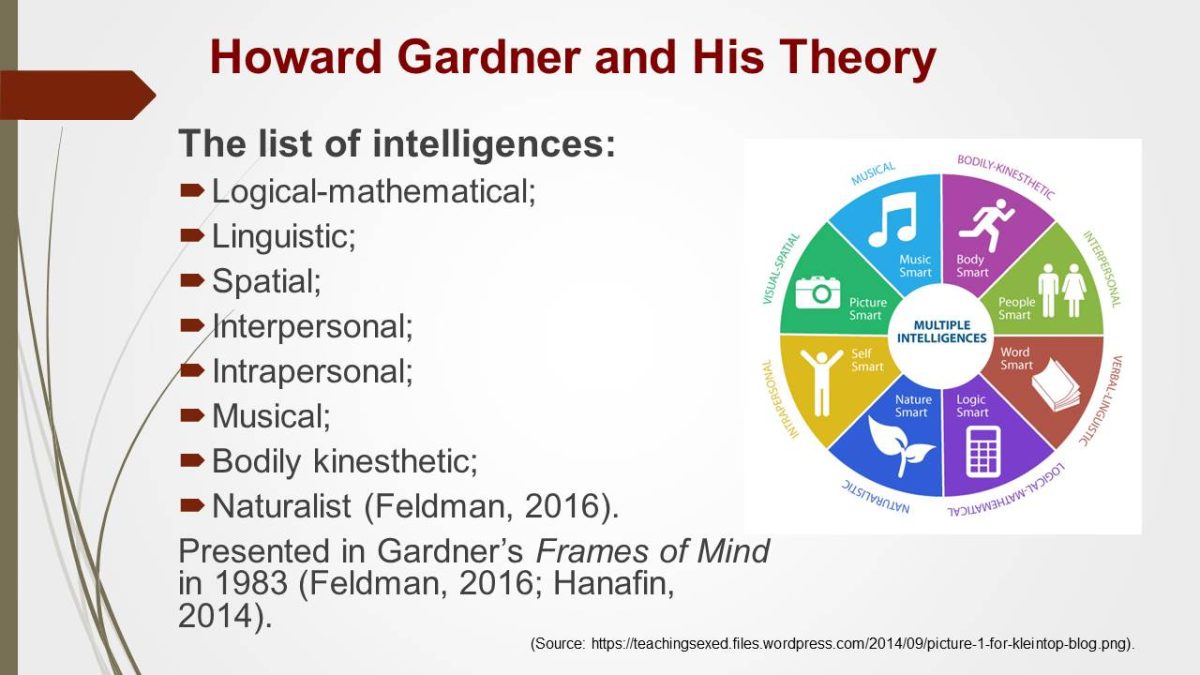
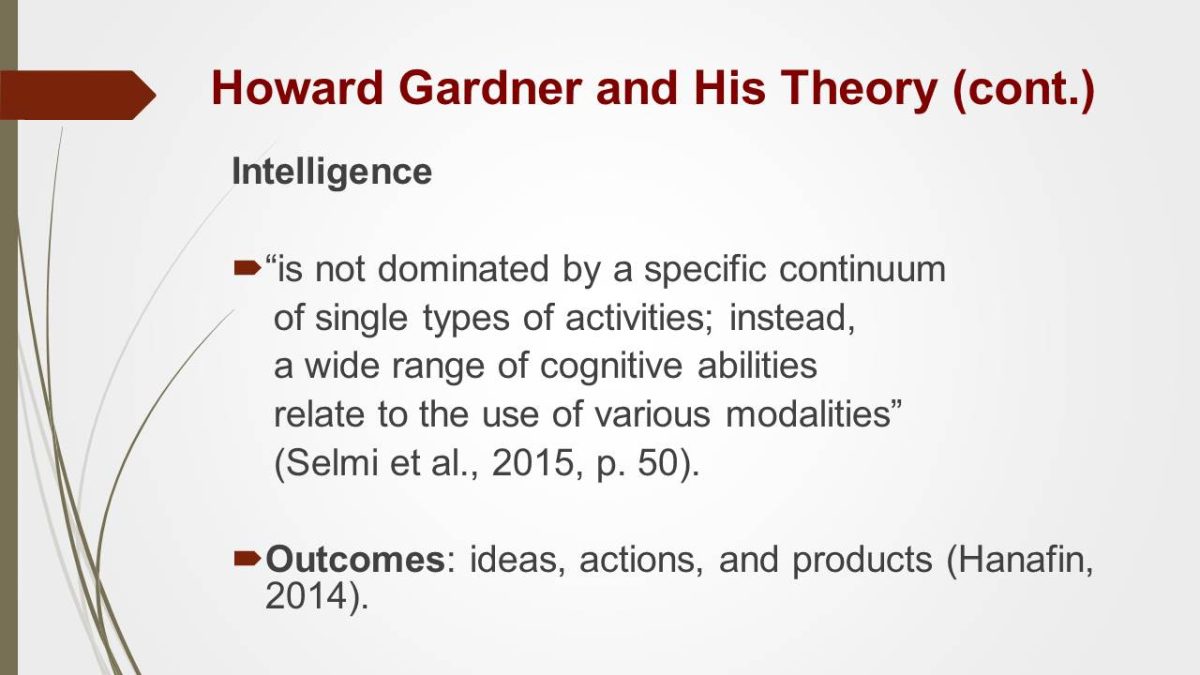
Key Principles of Theory of Multiple Intelligences
Intelligence is:
- a person’s potential for developing skills (Selmi et al., 2015);
- based on psychological, intellectual, and physical abilities;
- a modality with reference to which learners receive knowledge and experience.
- Students can choose preferred modalities for learning.
According to the Theory of Multiple Intelligences, while being unstable, intelligence represents a person’s potential for developing certain skills based on psychological, intellectual, and physical abilities (Selmi et al., 2015). Furthermore, there is a potential for the existence of more than eight intelligences, and the list can include existential or psychological intelligences among others. Different intelligences can also be viewed as modalities with reference to which learners receive knowledge and experience (Selmi et al., 2015). If a learner has the developed linguistic intelligence, this modality can be viewed as preferred one for learning, and a person can perform tasks better if they are presented in the form of spoken or written words.
- Learning with the help of dominant modalities is effective/successful (Selmi et al., 2015).
- All learners should study with reference to their preferred modality (Hanafin, 2014).
- Intelligences’ development is a culturally determined process.
- Ideas are supported by sociological, psychological, and neurobiological studies (Hanafin, 2014).
It is important to note that those students who learn with the help of their dominant modality are more successful than those ones who need to cope with challenging tasks presented in the context of other modalities (Selmi et al., 2015). In education, the application of the Theory of Multiple Intelligences means that all learners should be provided with opportunities to study with reference to their preferred modality in order to succeed (Hanafin, 2014). Gardner supported his theory with the help of evidence from sociological, psychological, and neurobiological studies (Hanafin, 2014). In addition, Gardner found that the development of intelligences is a culturally determined process.
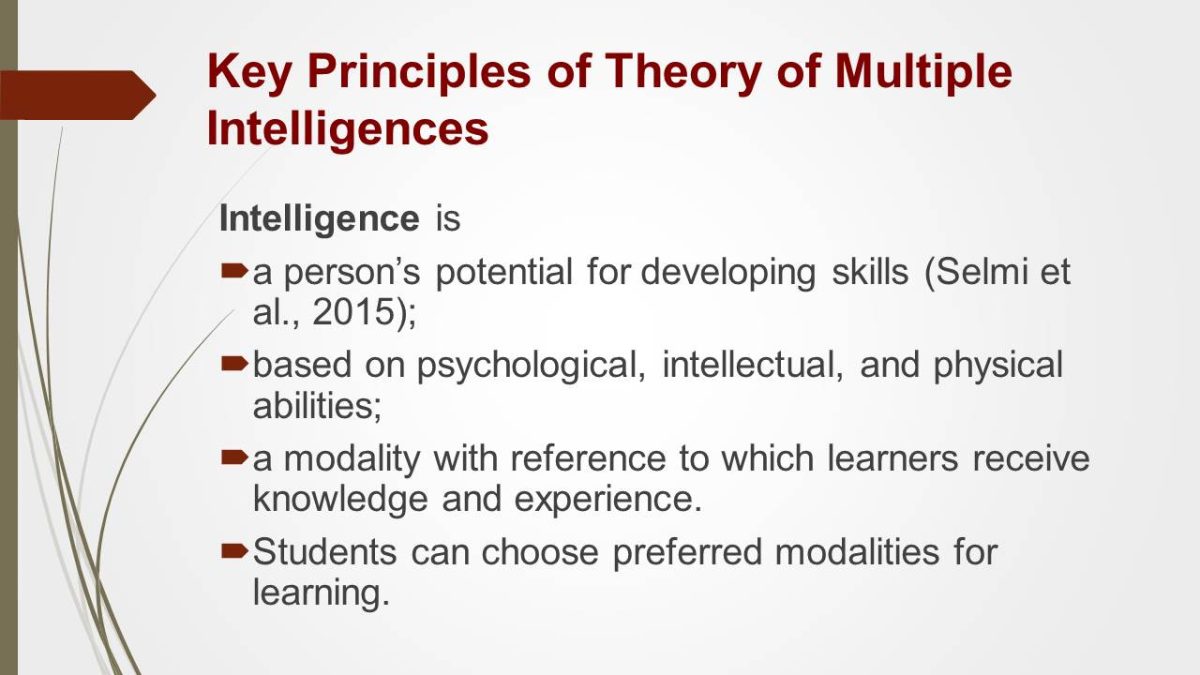
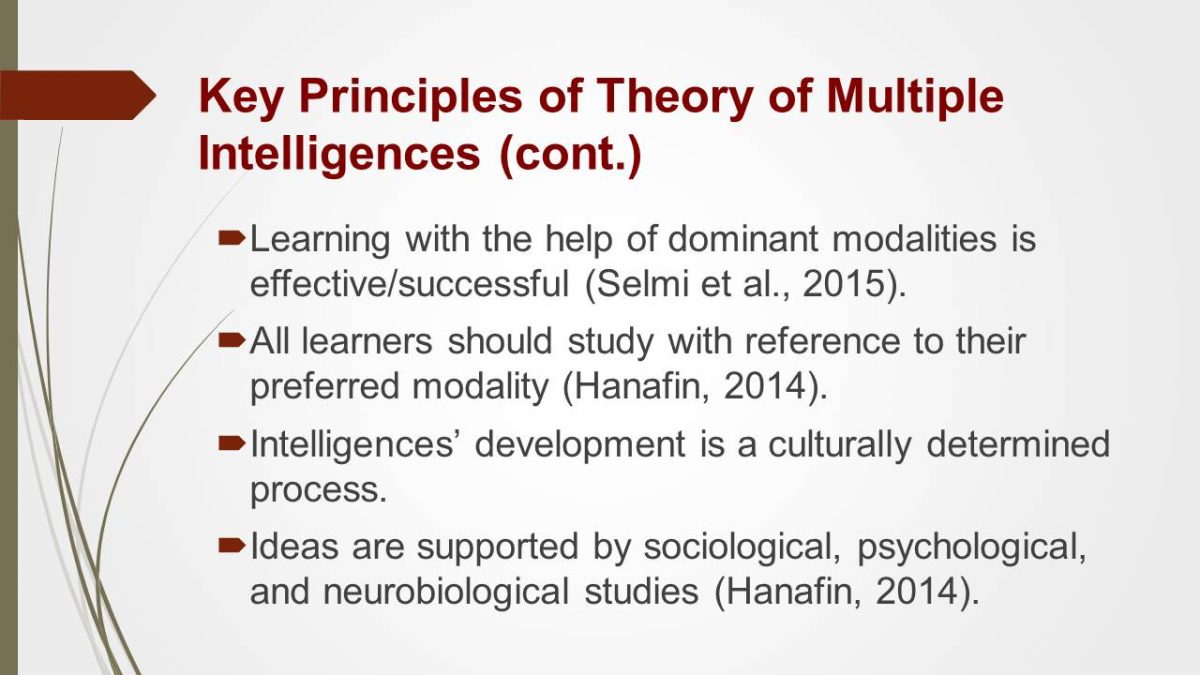
Logical-Mathematical Intelligence
Learners
- easily resolve problems and use analytical skills;
- make calculations, perform mathematical operations;
- demonstrate scientific thinking (Hanafin, 2014);
- analyze reasons and choose solutions;
- classify and categorize objects and phenomena;
- select logical patterns (Selmi et al., 2015);
- succeed as mathematicians, scientists, and technicians.
The logical-mathematical intelligence is associated with capacities to resolve problems, make calculations and perform different mathematical operations, use analytical skills, and demonstrate scientific thinking (Hanafin, 2014). Individuals demonstrate this intelligence when they analyze reasons, choose solutions, classify and categorize objects and phenomena, and select logical patterns among others tasks (Selmi et al., 2015). Logical-mathematical learners are oriented to using the conceptual knowledge rather than abstract one. Those learners whose logical-mathematical intelligence is developed perfectly succeed as mathematicians, scientists, and technicians.
Logical-mathematical learners
- prefer information presented as numbers, equations, and logical problems;
- use these symbols and approaches in different environments (Selmi et al., 2015);
- apply specific terminology;
While cooperating:
- develop strategies for resolving tasks;
- perform as decision-makers (Hanafin, 2014).
It is important to pay attention to the fact that logical-mathematical learners succeed when they work with the information presented in the form of numbers, equations, and logical problems (Selmi et al., 2015). These approaches can be used even when tasks are not related to science or mathematics. Thus, it is possible to state that these learners tend to apply specific terminology in their work. In addition, while cooperating with other people, logical-mathematical learners are able to develop strategies for resolving concrete tasks and perform as decision-makers (Hanafin, 2014).
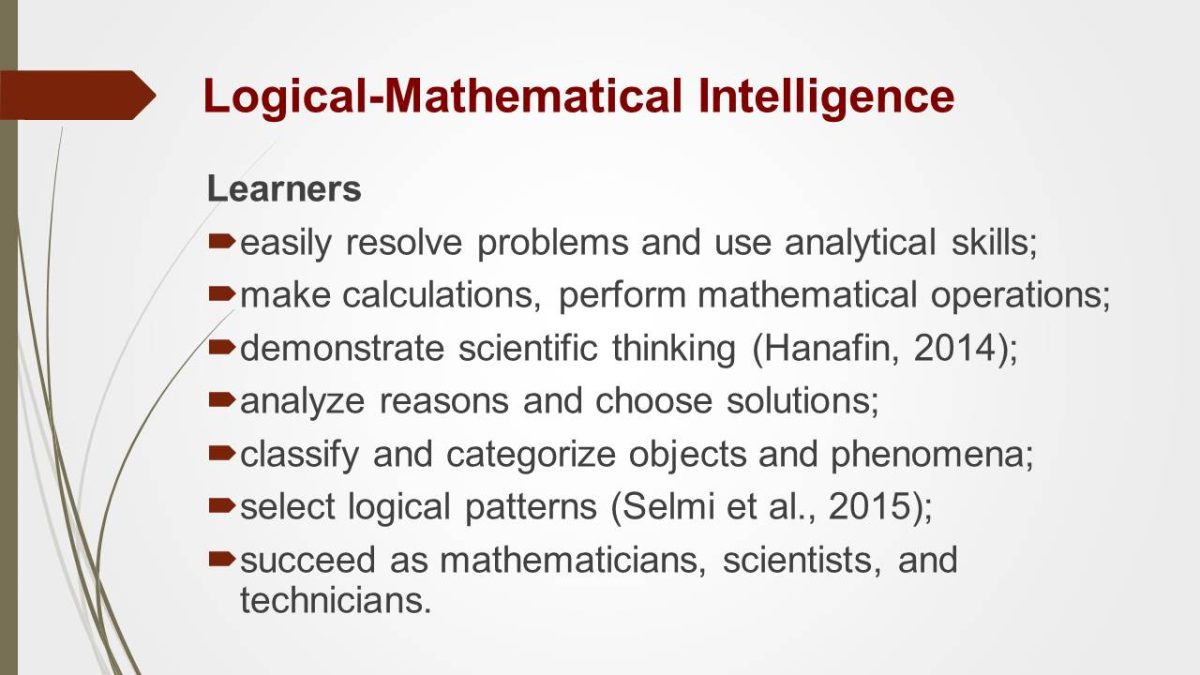
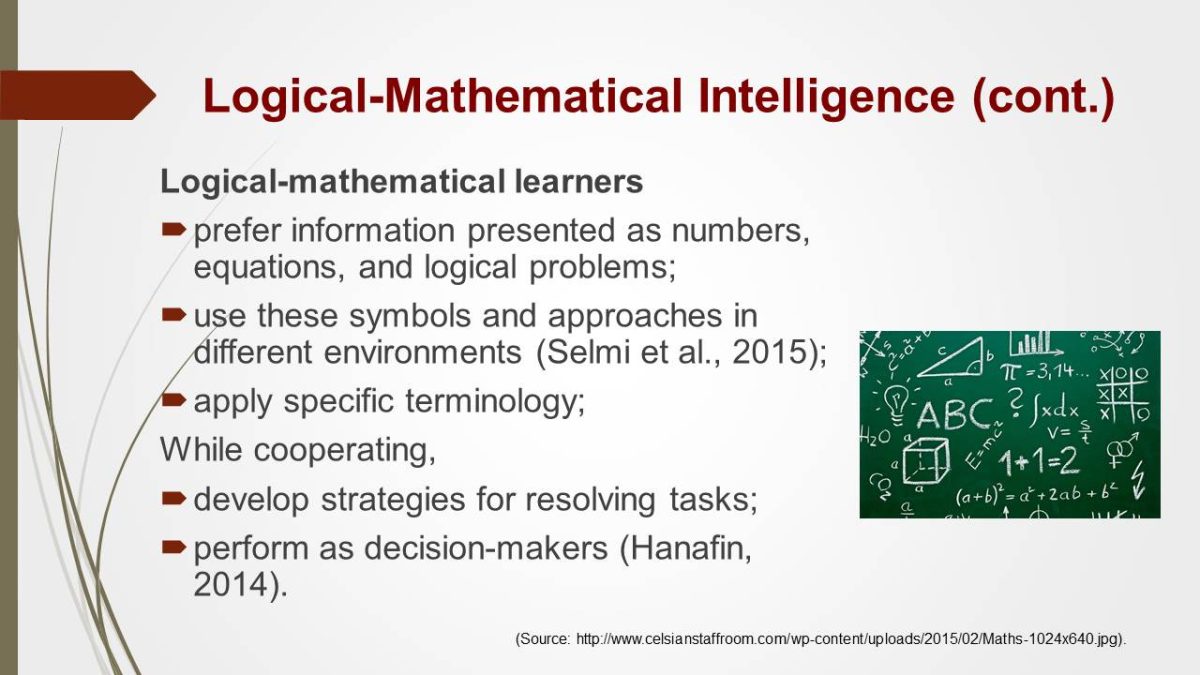
Linguistic Intelligence
Learners
- know and use language effectively;
- demonstrate skills in speaking and formulating verbal structures;
- read and write texts (Feldman, 2016);
- understand norms of using linguistic patterns and idioms (Selmi et al., 2015);
- develop as public speakers, journalists, writers, and editors.
The linguistic intelligence is related to knowing and using language. Thus, learners are expected to demonstrate skills in speaking and formulating verbal structures, reading texts, as well as writing (Feldman, 2016). Furthermore, this intelligence also includes the knowledge of norms of using certain linguistic patterns and idioms (Selmi et al., 2015). It is necessary to pay attention to the fact that those learners who demonstrate developed skills in the area of linguistic intelligence can work effectively as public speakers, journalists, writers, and editors. The representatives of these professions work with words oftener than representatives of other fields of knowledge.
- Educational institutions are oriented to logical-mathematical and linguistic learners (Selmi et al., 2015).
Linguistic learners succeed when:
- learn by reading, brainstorming, writing, story-telling, making notes;
- involved in creative writing, public speaking, and debating (Hanafin, 2014; Selmi et al., 2015).
As it was stated, according to Gardner, the system of education was focused on developing logical-mathematical and linguistic intelligence during a long period of time, and the progress in these intelligences was primarily measured in educational institutions to evaluate outcomes (Selmi et al., 2015). Today, it is possible to observe a tendency that modern education systems are also oriented to logical-mathematical and linguistic learners. The reason is that linguistic learners demonstrate higher results when they learn with the help of reading, brainstorming, writing, story-telling, as well as writing down their thoughts, goals, and ideas (Hanafin, 2014; Selmi et al., 2015). These students should be involved in creative writing, public speaking, and debating.
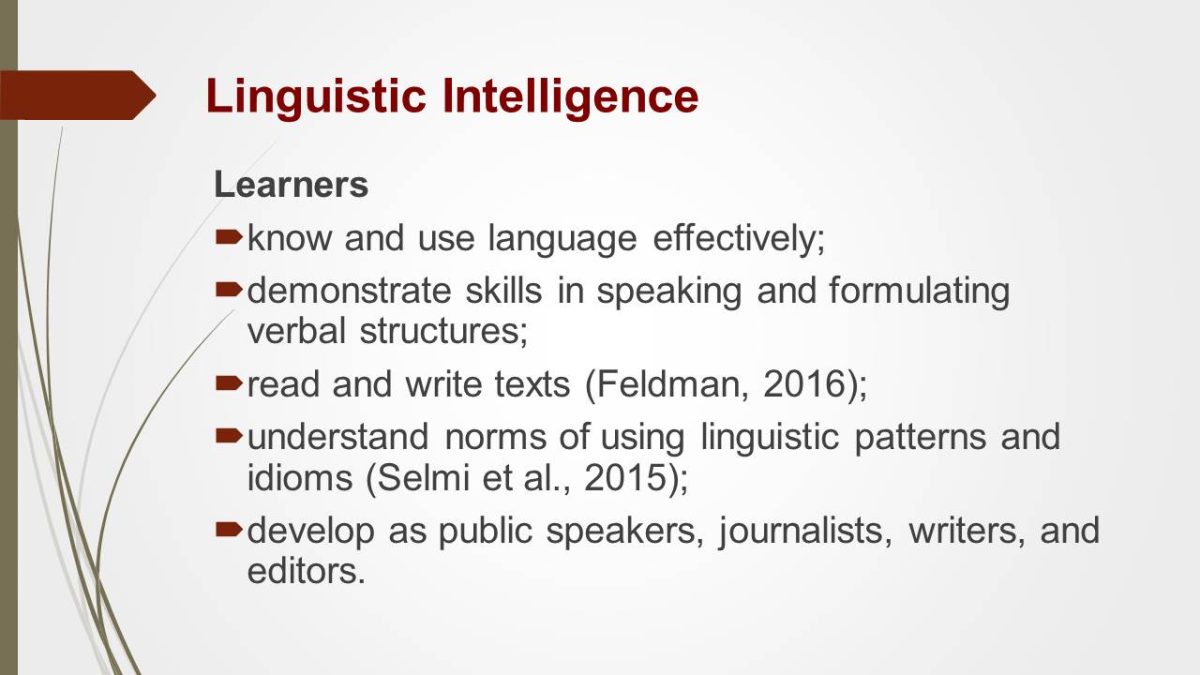
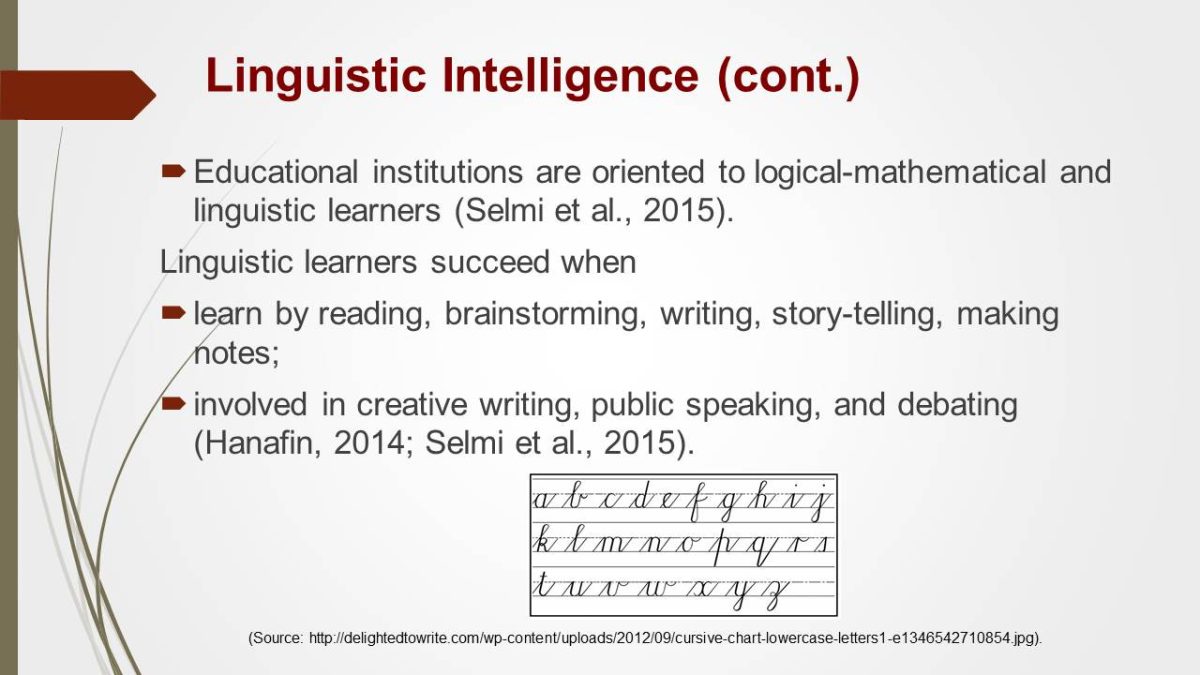
Spatial Intelligence
Learners
- understand and represent spatial configurations;
- visualize, draw, construct, design, and create;
- manipulate pictures, tables, figures, and maps to obtain knowledge (Feldman, 2016);
- work effectively with visualized objects, create new ones;
- develop as photographers, artists, architects, and designers (Selmi et al., 2015);
- Known as the visual-spatial intelligence.
The spatial intelligence is related to specific abilities to understand and represent spatial configurations, as well as to visualize, draw, construct, design, and create. It is important to note that learners with the developed spatial intelligence are inclined to manipulate pictures, as well as to work with tables, figures, and maps in order to obtain the required knowledge. In this case, visuals and models are perceived by learners more effectively than words or numbers (Feldman, 2016). These individuals not only work effectively with visualized objects, but they also tend to create new ones. As a result, the spatial intelligence helps people become photographers, artists, architects, and designers (Selmi et al., 2015).
Persons
- learn by manipulating figures and pictures;
- use visuals, graphs, illustrations, flashcards, and maps, different colors (Selmi et al., 2015);
- organize the studied material in tables;
- draw charts.
The spatial intelligence in the spheres of psychology and education is also known as the visual-spatial one because individuals learn by manipulating figures and pictures. In order to develop spatial intelligence and help these learners improve skills in other areas, it is important to use visuals, graphs, illustrations, flashcards, and maps at lessons (Selmi et al., 2015). The use of different colors can also be effective to attract these learners’ attention and make them focus on objects. To understand the information, these learners can organize the studied material in tables, as well as draw charts.
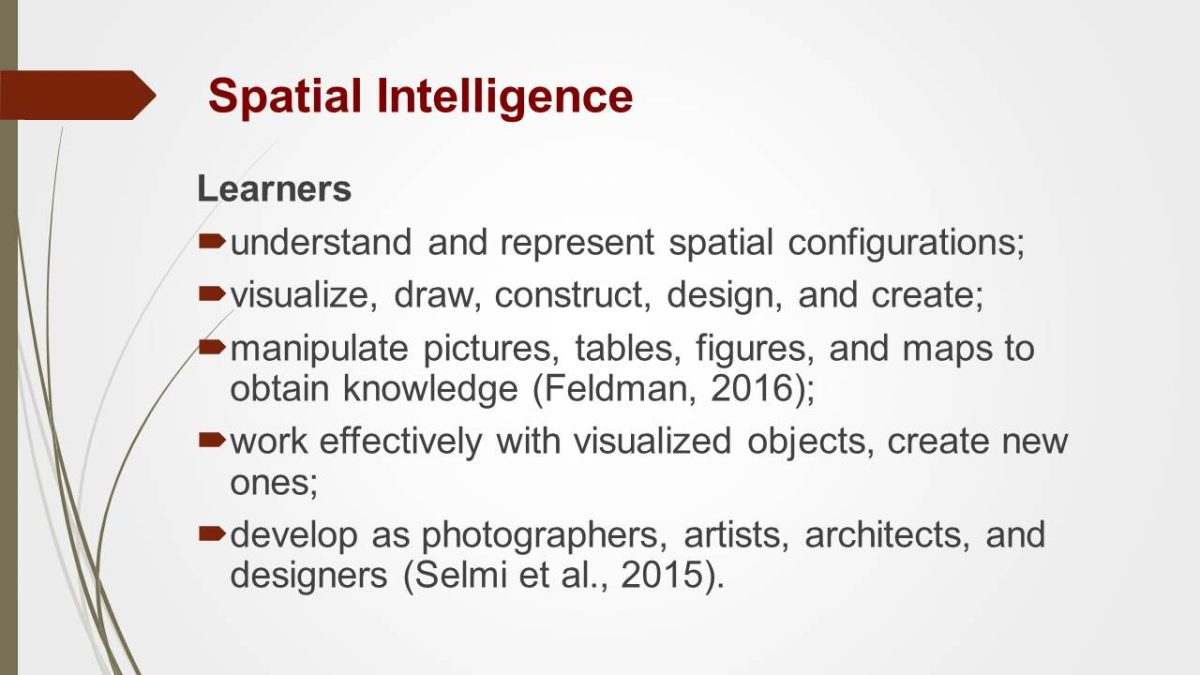

Interpersonal Intelligence
Learners
- effectively interact with other people;
- understand individuals’ moods, interests, feelings, and intentions (Feldman, 2016; Selmi et al., 2015);
- successful communicators and motivators;
- easily build relationships with peers;
- sensitive to others’ wishes, feelings, and thoughts;
- effectively collaborate and participate in surveying and teaching activities (Hanafin, 2014);
- develop as educators, psychologists, and social workers.
The interpersonal intelligence is associated with people’s abilities to interact with other individuals while demonstrating the understanding of their moods, interests, feelings, and intentions (Feldman, 2016; Selmi et al., 2015). Those learners who have rather developed interpersonal skills effectively interact with other people, and they are successful communicators and motivators. They easily build relationships with peers, and they are sensitive to their wishes, feelings, and thoughts (Hanafin, 2014). As a result, these learners’ skills in cooperation are also high. It is also important to note that such learners prefer to play with each other, communicate, collaborate, as well as participate in surveying and teaching activities (Hanafin, 2014). The developed interpersonal intelligence is important for educators, psychologists, and social workers.
Persons
- learn by social experience;
- interested in discussing problems, sharing opinions, and working as a team (Feldman, 2016; Selmi et al., 2015);
- motivated by the participation in meetings and collective activities.
While concentrating on the aspect of study, it is important to state that interpersonal learners develop their skills and abilities with reference to social experience. They are usually interested in discussing problems, sharing opinions, and working as a team (Feldman, 2016; Selmi et al., 2015). Therefore, educators need to pay attention to involving these learners in group activities in order to achieve higher results in the study. Furthermore, it should be noted that these students are usually motivated by the participation in meetings and collective activities.
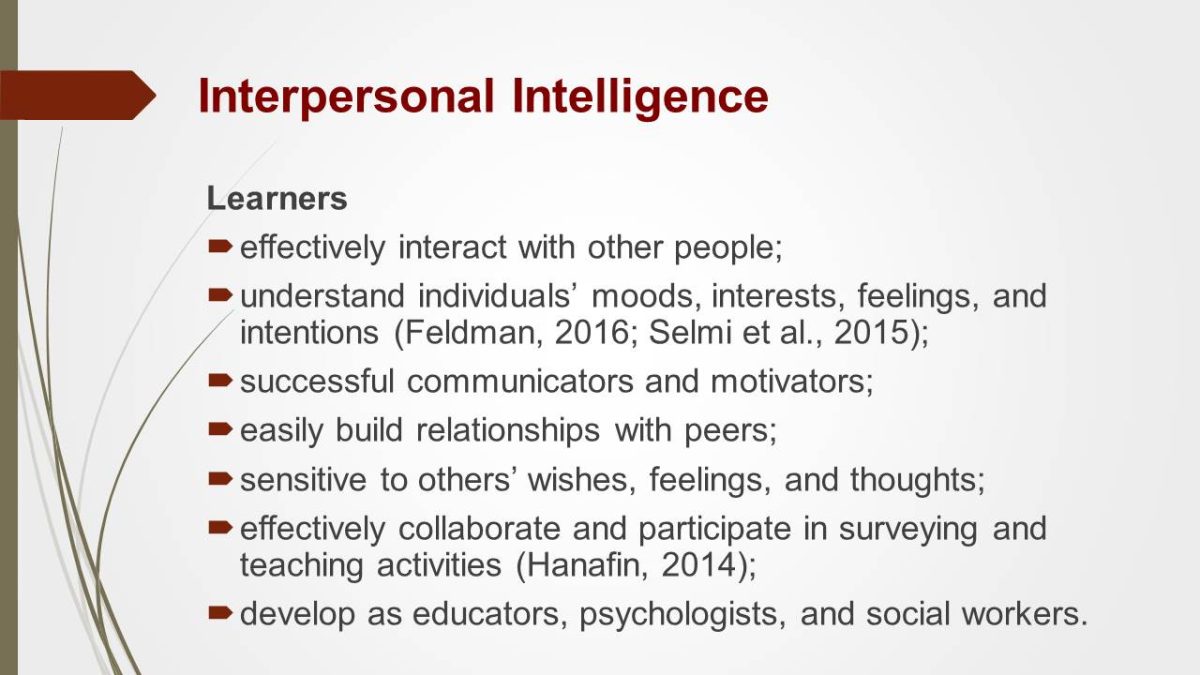
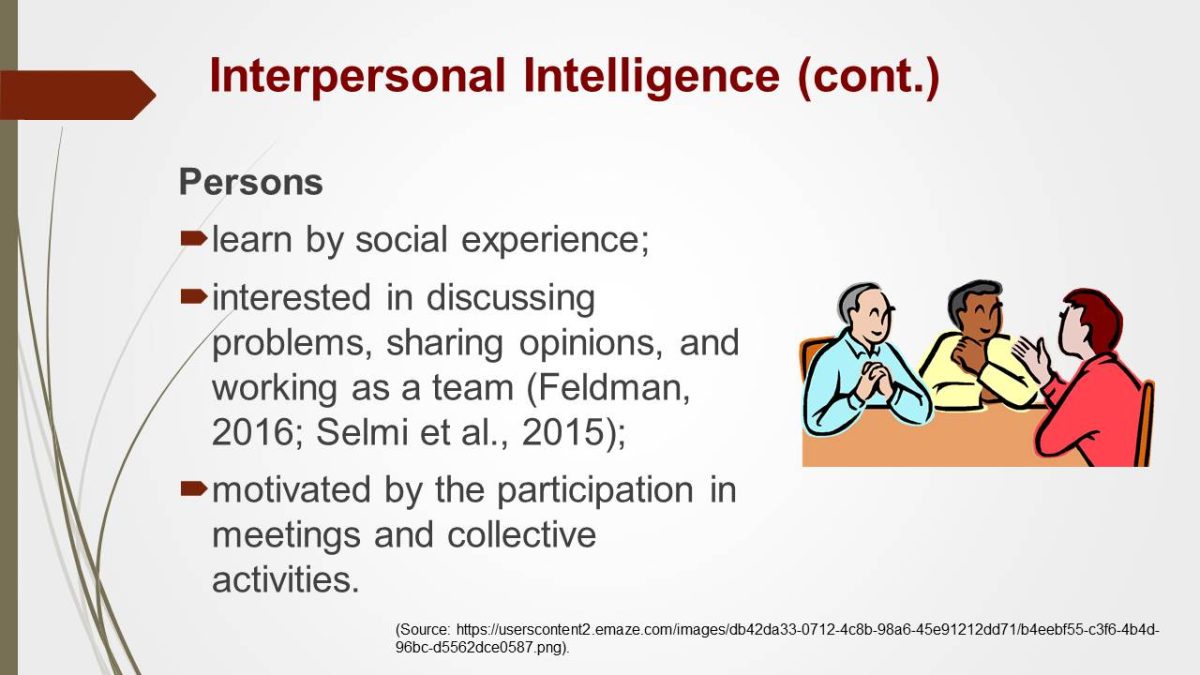
Intrapersonal Intelligence
Learners
- self-oriented;
- understand and analyze their own emotions, feelings, and concerns;
- able to reflect, complete self-assessments, dream, achieve goals based on the analysis of their emotions and desires (Selmi et al., 2015);
- prefer to study and work independently;
- experience problems with cooperating in teams (Hanafin, 2014).
The intrapersonal intelligence is associated with understanding one’s own emotions, feelings, and concerns. Such learners are focused on analyzing their thoughts and feelings in detail in order to make certain conclusions. In addition, it is important to note that they demonstrate abilities to reflect and complete self-assessments. Furthermore, such people often dream, and they can set and achieve goals that are based on the analysis of their emotions and desires (Selmi et al., 2015). These learners study better as independent individuals because they can experience problems with cooperating in teams. Thus, self-oriented learners with the developed intrapersonal intelligence can demonstrate the best results when they work on tasks independently (Hanafin, 2014).
Persons
- learn by self-reflection, rewording tasks, thinking over examples, and focusing on familiar points (Hanafin, 2014);
- often keep journals and analyze their learning.
- Autonomous learning is preferred in contrast to group learning.
Researchers state that people with the developed intrapersonal intelligence study better with the help of self-reflection (Hanafin, 2014). Educators can ask such learners to reword tasks, think over examples, and focus on points that help them feel comfortable with the studied material (Hanafin, 2014). These students like to keep journals and analyze their learning process. Educators can expect better results when these individuals choose autonomous learning rather than the participation in group learning.
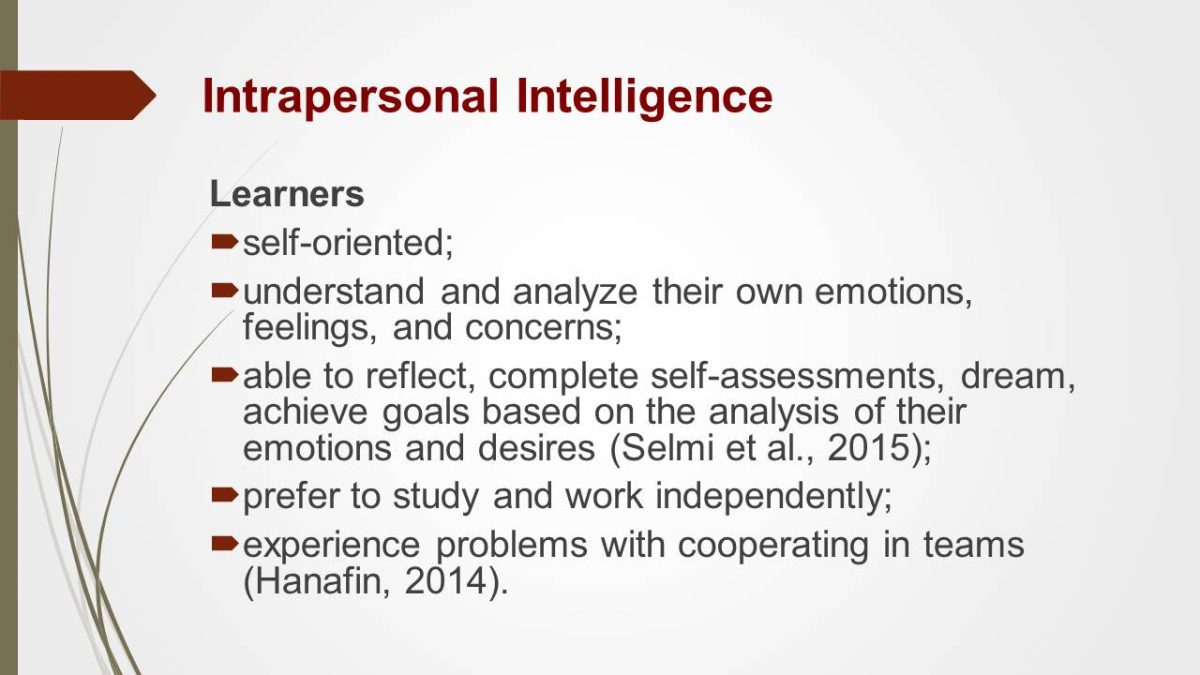
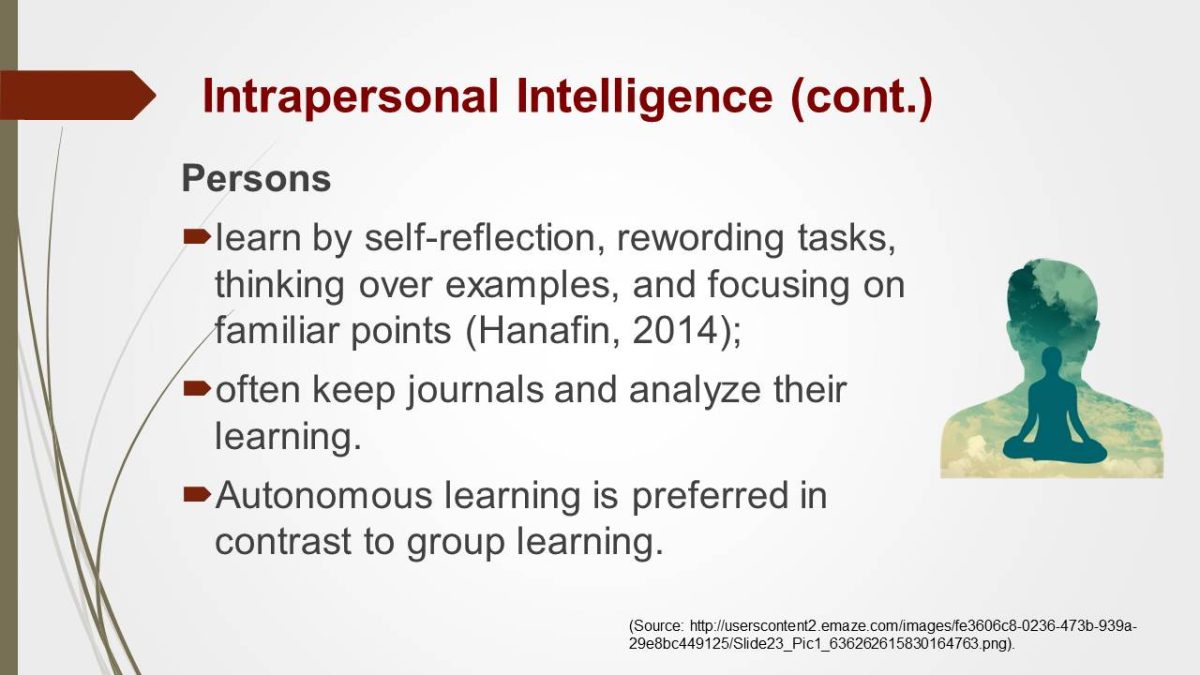
Musical Intelligence
Learners
- understand and perform music;
- sensitive to rhythms, melodies, any sounds and noises;
- demonstrate abilities in composing, rhyming, and singing;
- prefer to listen to background melodies while studying (Selmi et al., 2015).
The musical intelligence is related to developing skills and abilities in understanding and performing music. These learners are sensitive to sounds, rhythms, and melodies. They can demonstrate abilities in composing, rhyming, and singing. It is important to note that these learners are sensitive not only to music but also to any sounds and noises around them because of the developed auditory channel. In order to read, understand, and learn some material, these individuals can listen to background melodies or reproduce some rhythms (Selmi et al., 2015). In this case, music is not a distracting factor for these learners.
- Educators can encourage sound learners to use music.
- Learners can use musical associations.
- These learners can be interested in participating in extracurricular activities (Hanafin, 2014).
As it was stated, sound learners can be encouraged to use music in order to support their study process. Furthermore, they can also refer to different musical associations while working with texts and solving problems. Researchers pay attention to the fact that such learners are often interested in participating in extracurricular activities (Hanafin, 2014).
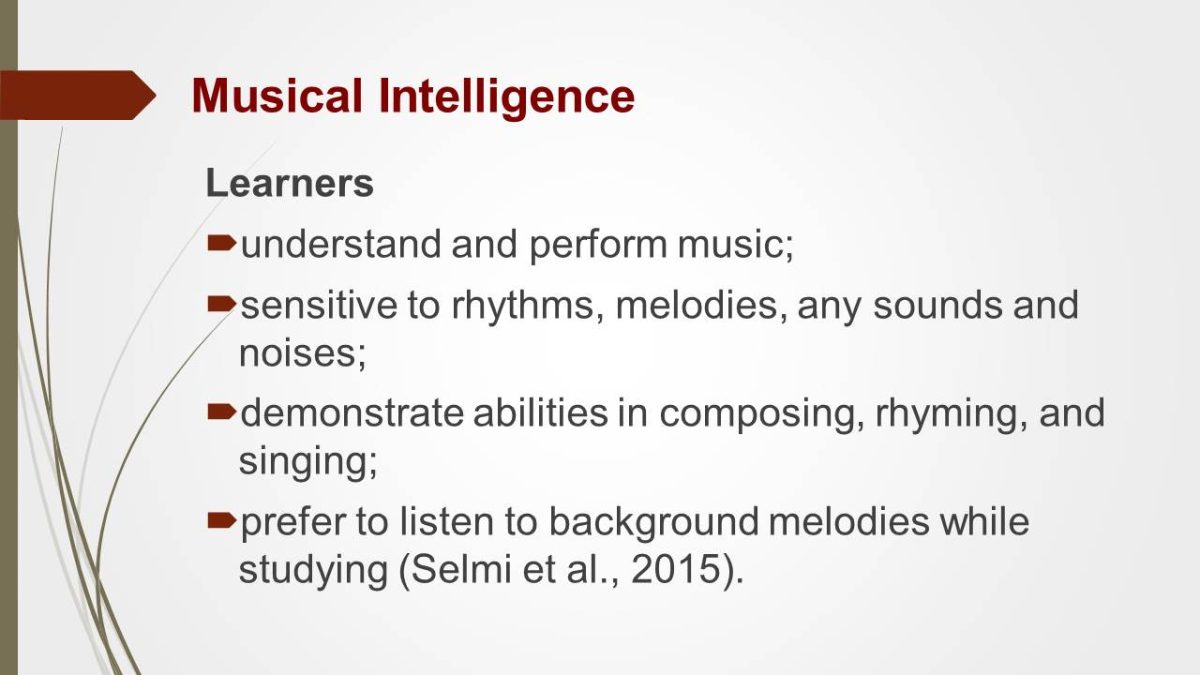

Bodily Kinesthetic Intelligence
Learners
- use one’s body to complete physical tasks (Feldman, 2016);
- effectively control their body movements;
- manipulate physical objects;
- participate in activities that include physical actions (Hanafin, 2014).
It is important to note that the bodily kinesthetic intelligence is related to the ability of using one’s body in order to complete certain physical tasks (Feldman, 2016). Learners are expected to be able to control their body movements, manipulate physical objects, and participate in certain activities that include physical actions (Hanafin, 2014). Some psychologists and educators note that the focus on this intelligence is rather questionable because Gardner concentrated on those physical activities that are expected to be demonstrated by all people at a certain stage of their development in spite of their specific cognitive progress (Hanafin, 2014; Selmi et al., 2015).
Persons
- learn by doing something, manipulating objects, and performing exercises (Hanafin, 2014; Selmi et al., 2015);
- refer to tactile feelings.
- Learners are good at sports and dancing;
- succeed as actors or dancers.
In learning, the bodily kinesthetic intelligence is associated not only with participating in sport activities but also with learning by doing something, manipulating objects, and performing exercises (Hanafin, 2014; Selmi et al., 2015). It is important to pay attention to the fact that such learners are usually good at sports and dancing, they succeed as actors or dancers. In addition, it is often important for these people to transform things in order to obtain the knowledge and refer to tactile feelings to make conclusions.

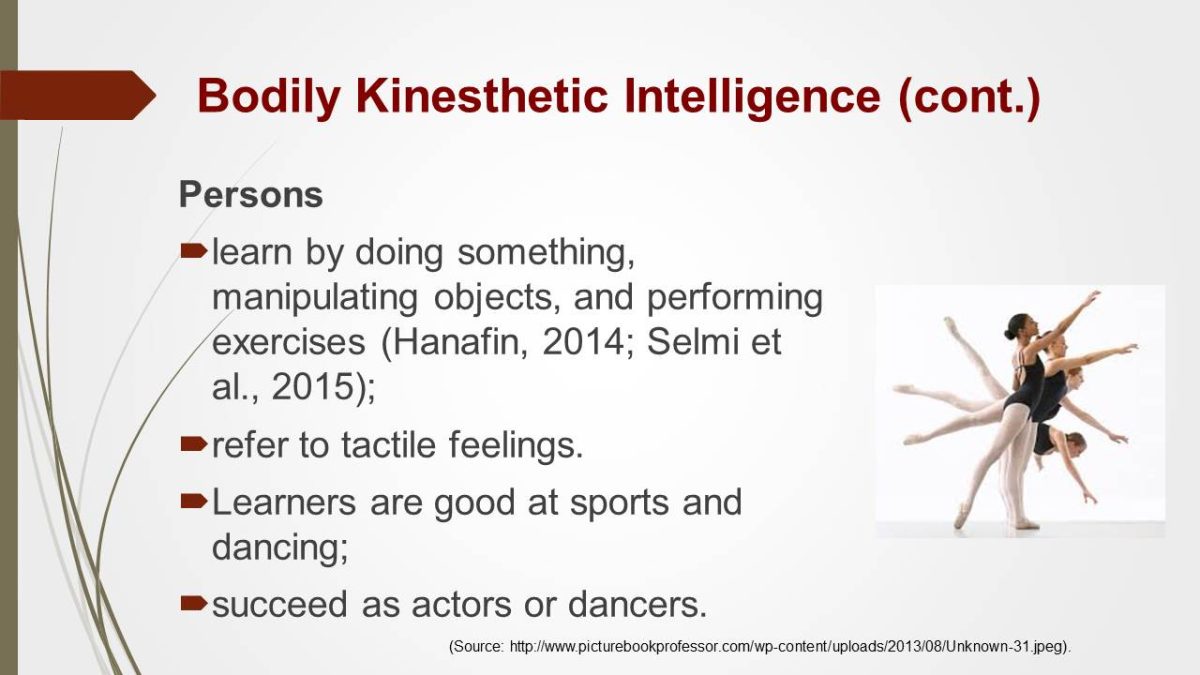
Naturalist Intelligence
Learners
- determine, understand, and categorize natural patterns and processes (Feldman, 2016);
- classify and describe animals and plants (Feldman, 2016; Selmi et al., 2015);
- interested in contacts with the nature;
- function effectively in natural environments (Hanafin, 2014).
The naturalist intelligence is associated with learners’ abilities to determine, understand, and categorize natural patterns and processes (Feldman, 2016). Thus, people with this intelligence are able to classify and describe animals and plants, and they understand natural processes associated with their surroundings (Feldman, 2016; Selmi et al., 2015). These learners are interested in contacts with the nature, and they function effectively in natural environments (Hanafin, 2014).
Persons
- demonstrate high results in Natural Studies;
- use the theoretical knowledge about natural processes;
- participate in naturalist project groups (Feldman, 2016; Selmi et al., 2015);
- develop as environmentalists, ecologists, and scientists.
In addition, while focusing on this intelligence, it is necessary to state that naturalist learners can demonstrate high results in Natural Studies while using the theoretical knowledge and participating in naturalist project groups (Feldman, 2016; Selmi et al., 2015). Environmentalists, ecologists, and scientists usually have the developed naturalist intelligence.
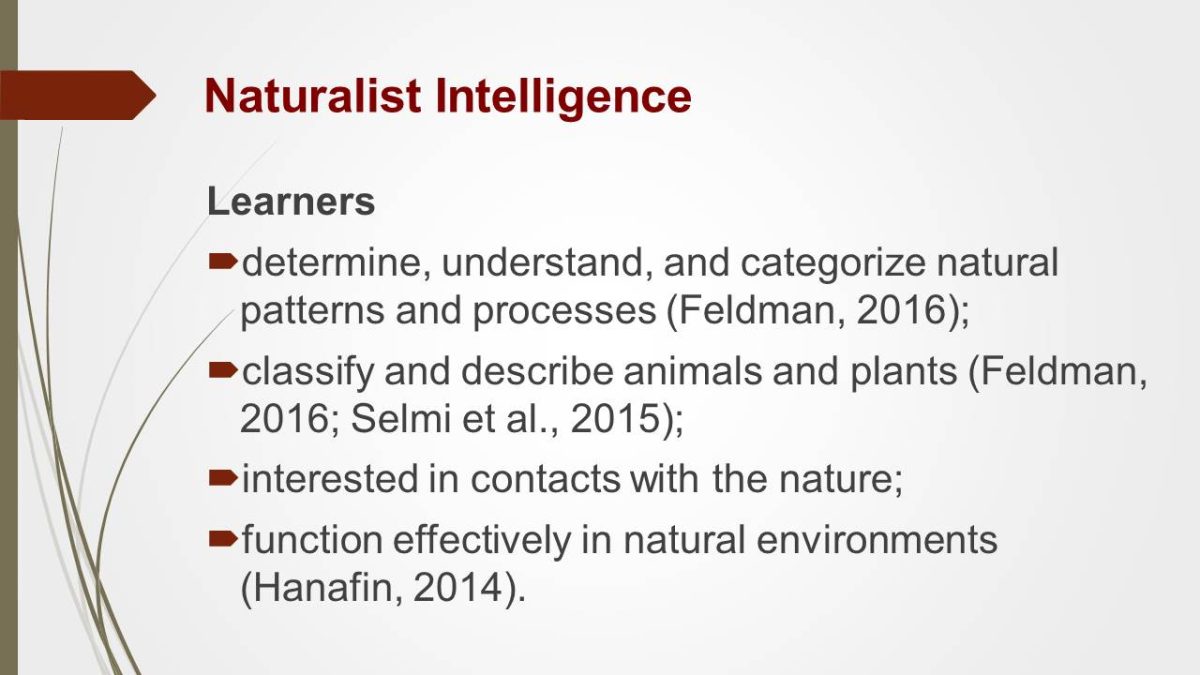
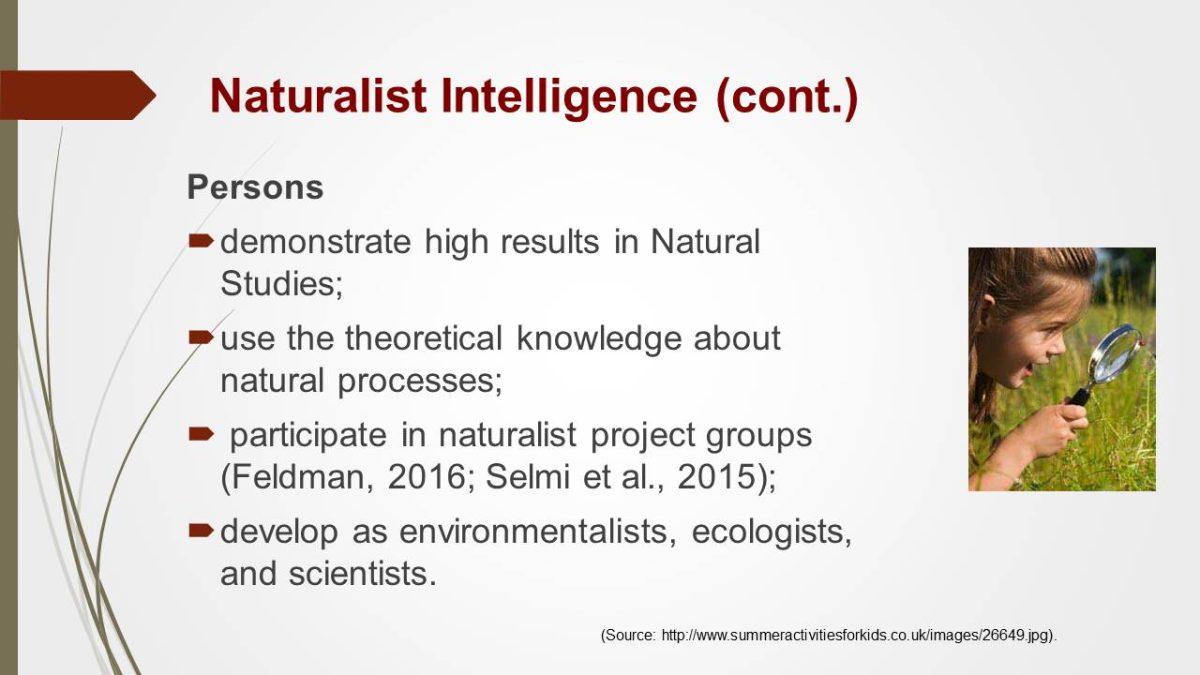
Conclusion
The Theory of Multiple Intelligences
- is important for the areas of psychology and education;
- explains how to teach and develop children depending on their preferences in learning;
- all persons are perceived as individuals with multiple intelligences.
It is important to conclude that Gardner’s Theory of Multiple Intelligences is significant for the areas of psychology and education because it explains how it is possible to teach and develop children depending on their preferences in learning and activities. Thus, it is possible to state that the theorist allowed perceiving all persons as individuals who can demonstrate high results in different areas depending on the development of their certain intelligences.
- The theory contributed to the development of theoretical models and concepts about learning styles.
- Inabilities to perform tasks are not viewed as deficits anymore.
- Educators are provided with tools to motivate students.
- Individuals can learn using favorite modalities.
As a result, in the sphere of education, inabilities to perform this or that task are not viewed as deficits in a child’s development anymore. Furthermore, it is important to pay attention to the fact that the theorist provided educators with tools to help students learn while focusing on favorite modalities in order to develop those intelligences that are not among preferred ones. From this point, the contribution of Howard Gardner and his Theory of Multiple Intelligences to the development of theoretical models and concepts about learning styles can be discussed as rather significant.
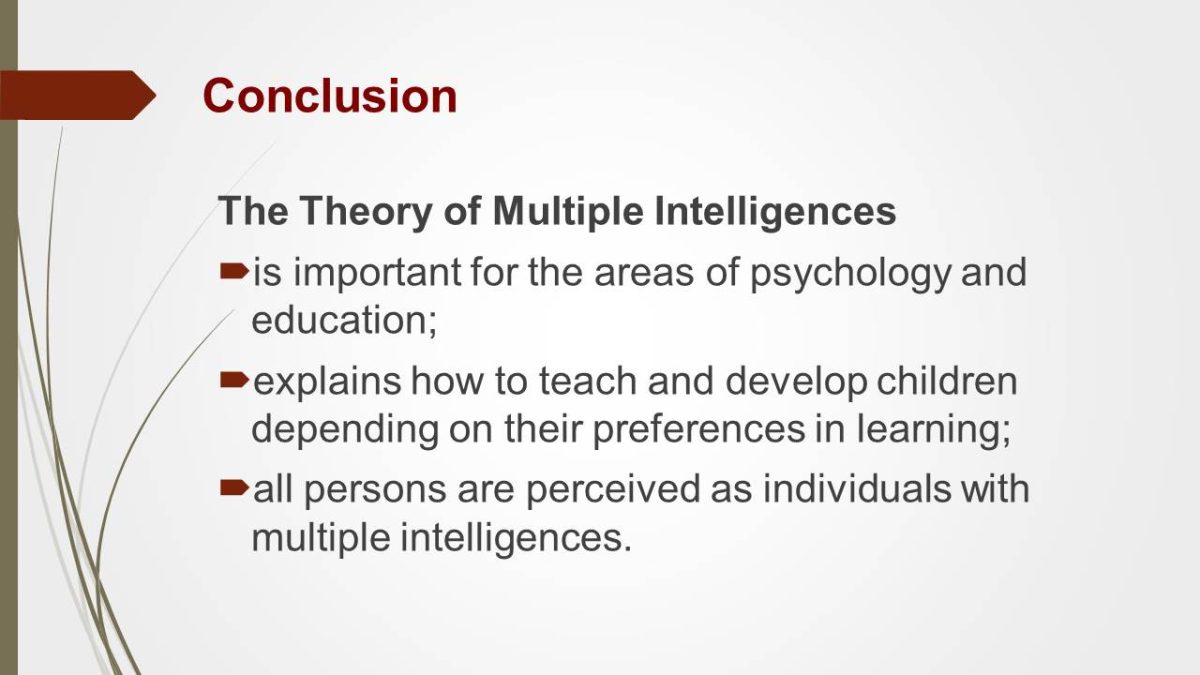
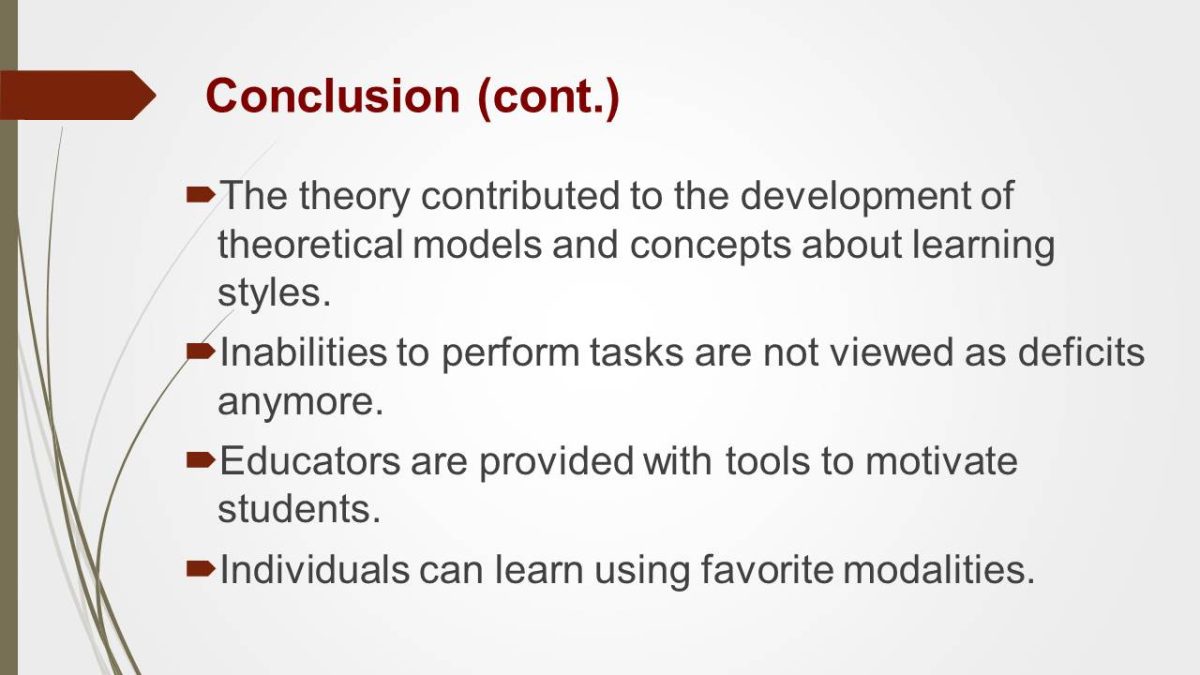
References
Feldman, R. S. (2016). P.O.W.E.R. learning: Strategies for success in college and life (7th ed.). Boston, MA: McGraw-Hill.
Hanafin, J. (2014). Multiple intelligences theory, action research, and teacher professional development: The Irish MI project. Australian Journal of Teacher Education, 39(4), 126-141.
Selmi, A. M., Gallagher, R. J., & Mora-Flores, E. R. (2015). Early childhood curriculum for all learners. Thousand Oaks, CA: SAGE Publications.